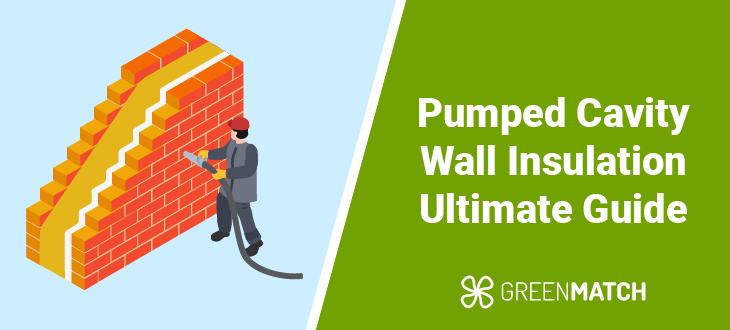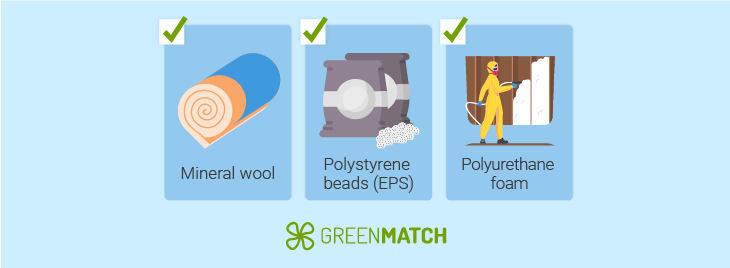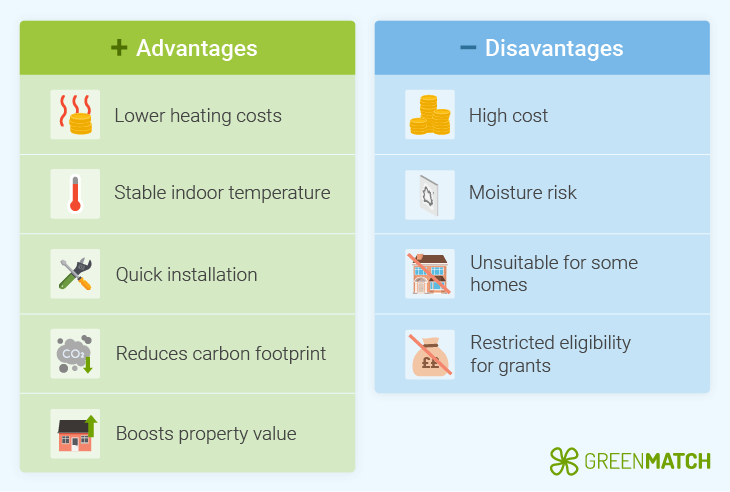Answer these simple questions and we will find you the BEST prices
Which type of solar quotes do you need?
It only takes 30 seconds
100% free with no obligation

Get Free quotes from insulation specialists near you

Save money by comparing quotes and choosing the most competitive offer

The service is 100% free and with no obligation
Pumped Cavity Wall Insulation: What Is It, Pros, Cons & Costs


- In England, Scotland, and Wales, cavity wall insulation costs range from £1,000 to £4,500, while in Northern Ireland, they are lower, between £500 and £2,200, depending on house type.
- Properly installed cavity wall insulation can save up to £470 on energy bills per year, depending on your home type.
- Cavity wall insulation also reduces carbon emissions, with annual CO₂ savings of up to 1,100 kg in England, Scotland, and Wales and up to 1,600 kg in Northern Ireland, depending on house type.
In an uninsulated home, roughly one-third of the heat loss occurs through the walls. Proper cavity wall insulation can significantly cut down on energy waste and reduce heating costs. According to the Energy Savings Trust UK, this upgrade could save you between £110 and £470 annually on energy bills.
This complete guide will show how pumped cavity wall insulation can make your home warmer, lower your energy bills, and reduce environmental impact. We’ll cover the main benefits, costs for different property types, and key things to consider, providing all the insights you need to determine if pumped insulation is the best fit for your home.
Ready to make your home warmer and cut those energy bills—but not sure where to start? Let us make it easy. We’ll connect you with up to 3 free quotes from trusted local insulation experts, who will ensure the job is done right, saving you the time and stress of searching yourself. Simply fill out our 30-second form, and we’ll cover the rest. Click below now!
- Describe your needs
- Get free quotes
- Choose the best offer
It only takes 30 seconds



What is pumped cavity wall insulation?
Pumped cavity wall insulation installation involves injecting insulating materials, such as mineral wool or polystyrene beads, into the gap between two layers of brickwork in a building's walls. This process enhances thermal resistance, effectively reducing heat loss and improving energy efficiency.
The effectiveness of insulation is measured by its R-value, which indicates the material's resistance to heat flow—the higher the R-value, the better the insulation. For pumped materials commonly used in cavity wall insulation, the R-value is:
- Mineral wool: 2.5 to 3.3 m²K/W
- Polystyrene beads: 2.6 to 3.3 m²K/W
- Polyurethane foam: 3.6 to 4.5 m²K/W
To check if your home has cavity walls, look at the build date and brick pattern: post-1920s homes usually have cavity walls with bricks in a regular pattern, while pre-1920s homes likely have solid walls with an alternating brick layout.
If unsure, measure the wall—over 260mm likely means a cavity, while thinner walls are probably solid. It’s always best to consult an insulation specialist, especially for timber or prefabricated homes.
Types of pumped cavity wall insulation

Pumped cavity wall insulation uses several materials to enhance your home’s energy efficiency. Here’s a look at the top cavity wall insulation types, their benefits, sustainability, and cost per m²:
Mineral wool
This material costs around £13 - £17.5 per m². It is made from spun rock or glass fibres, which provide excellent insulation and soundproofing. It’s durable, moisture-resistant, and non-combustible, making it ideal for safe, effective insulation. Mineral wool is a recyclable insulation material and has low embodied energy, making it a more environmentally friendly choice.
Polystyrene beads (EPS)
Polystyrene beads are priced at approximately £10 per m². They are lightweight and water-resistant, reducing the risk of dampness in the walls. They expand upon installation to fill the cavity effectively, offering consistent insulation performance. Although EPS is derived from petroleum, some varieties are recyclable, providing options with a lower environmental impact.
Polyurethane foam
Costing around £21.5 per m², this insulation foam expands after being pumped into walls, creating an airtight seal that’s highly effective in reducing heat loss. It’s especially beneficial in homes needing a solid air barrier. While effective, polyurethane is less sustainable due to its chemical composition, making it a less eco-friendly insulation option.
Each of these materials offers unique advantages, from affordability to enhanced durability, and can be selected based on your insulation needs, budget, and environmental priorities.
Pumped cavity wall insulation prices
On average, the cost of pumped cavity wall insulation for a semi-detached home in the UK is approximately £2,700.
The total cost of cavity wall insulation varies by property type, from detached houses to mid-floor flats. We’ve outlined typical installation costs, energy bill savings, and CO₂ savings across regions to give you a clear view of potential expenses and benefits.
| House type | Typical installation cost (£) | Energy bill savings (£/year) | Carbon dioxide savings (kgCO₂/year) |
|---|---|---|---|
| Detached house | £4,300 | £410 | 1,100 |
| Semi-detached house | £2,700 | £240 | 650 |
| Mid-terrace house | £1,500 | £140 | 380 |
| Detached bungalow | £2,000 | £180 | 490 |
| Mid-floor flat | £1,100 | £110 | 310 |
Now, let’s take a look at Northern Ireland.
| House type | Typical installation cost (£) | Energy bill savings (£/year) | Carbon dioxide savings (kgCO₂/year) |
|---|---|---|---|
| Detached house | £2,100 | £470 | 1,600 |
| Semi-detached house | £1,300 | £270 | 900 |
| Mid-terrace house | £750 | £160 | 550 |
| Detached bungalow | £1,000 | £200 | 700 |
| Mid-floor flat | £550 | £130 | 430 |
Factors affecting the cost
Several key factors impact the cost of pumped cavity wall insulation:
- Material choice: Different insulation materials each come with their own price per m².
- Wall size: Larger properties require more insulation material, increasing the overall cost. For example, insulating a 90 m² wall surface would cost between £900 and £1,935.
- Labour rates: Labour costs vary widely by region, affecting the total installation price. Labour in high-demand areas, such as London, tends to be more expensive, while rates in rural areas are often lower.
- Eligibility for grants: Government insulation grants may help reduce costs through schemes like the GBIS, ECO4, and local authority schemes, which often support low-income families. Contact your local council or energy supplier for eligibility details.
With these impressive annual savings, are you ready to transform your home? Let us make it easy for you. Get up to 3 free quotes from trusted insulation experts near you. Skip the stress of endless research and comparisons—just fill out our quick 30-second form, and we’ll handle everything. Get started now!
- Describe your needs
- Get free quotes
- Choose the best offer
It only takes 30 seconds



Pros and cons of pumped insulation
Pumped cavity wall insulation can be a smart choice for enhancing your home’s energy efficiency, but it’s essential to weigh the benefits and potential drawbacks. Here’s a clear breakdown to help you decide.

Pros
Pumped cavity wall insulation offers several key benefits that make it an attractive choice for homeowners:
- Significant energy savings: By pumping insulation into cavity walls, you can drastically reduce heat loss, keeping warmth inside and cutting down on heating bills and saving between £110 to £470 on energy bills annually.
- Enhanced comfort: This insulation type creates a more consistent indoor temperature, making your home warmer in winter and cooler in summer. Say goodbye to drafts and fluctuating temperatures.
- Quick and non-disruptive installation: A cavity insulation pump system allows for fast, minimally invasive installation. Professionals typically complete the job within a few hours, with little disruption to your day-to-day life.
- Environmentally friendly: Lowering heat loss reduces your carbon footprint, helping you contribute to a more sustainable planet. The CO₂ savings from pumped wall insulation are substantial, making it an eco-conscious choice.
- Increased property value: Insulating your walls can add value to your property by improving its energy efficiency rating—a feature that appeals to eco-conscious buyers in the UK.
Cons
There are also some potential drawbacks to consider before deciding on pumped cavity wall insulation:
- Initial cost: The upfront cost of installation may be a concern for some homeowners, particularly if your property is large or has extensive wall space. However, government grants or energy savings can help offset this over time.
- Moisture and dampness risk: If not installed correctly, or if there’s existing moisture in the walls, pumped insulation may trap moisture, leading to dampness and even mould. It’s essential to have a professional inspection to ensure your walls are suitable.
- Limited compatibility: Pumped cavity wall insulation isn’t suitable for all properties. Older homes with solid walls or timber-framed structures may not be compatible. In such cases, alternative insulation methods might be required.
- Grant restrictions: While government schemes are available to help with insulation costs, not all households qualify. Eligibility can be restricted by income, property type, or energy efficiency requirements.
By understanding the pros and cons, you can make an informed choice about your wall insulation.
Is pumped wall insulation worth it?
If you're considering pumped wall insulation, the benefits are clear: reduced heat loss, lower energy bills, and a warmer, more comfortable home. This type of insulation is highly effective at keeping warmth in during colder months, helping you save significantly on heating costs while shrinking your carbon footprint.
However, to ensure these benefits, professional installation is essential. An expert cavity wall insulation installer uses specialised equipment and understands the precise techniques to fill cavity walls thoroughly, achieving maximum energy efficiency.
According to the UK government, Cavity Wall Insulation (CWI): Consumer Guide to Issues Arising from Installations, homeowners should check if their insulation is covered by a guarantee, often provided by organisations like CIGA. Additional support is available through Ofgem for installation issues under the ECO scheme.
Poorly installed insulation can trap moisture in walls, leading to issues like mould, structural damage, and even health risks. Attempting DIY or choosing an unqualified installer may seem cheaper initially but can result in expensive repairs and persistent moisture problems down the line.
Ready to transform your home with pumped wall insulation? Don’t leave your investment to chance or risk costly mistakes. Get up to 3 free quotes from trusted, vetted insulation specialists near you. Avoid the stress and potential hazards of improper installation. Fill out our quick form, and we’ll connect you with qualified professionals who meet these standards and can ensure your insulation is done safely and effectively.
- Describe your needs
- Get free quotes
- Choose the best offer
It only takes 30 seconds



FAQ
Yes, you can pump insulation into cavity walls using specialised equipment. This process fills the gap between exterior walls with materials like mineral wool or polystyrene beads to improve insulation.
Pumping cavity wall insulation is an effective way to reduce heat loss, lower energy bills, and increase home comfort. It’s especially beneficial for homes with uninsulated cavity walls, though suitability depends on the property type and wall condition.
Mineral wool and expanded polystyrene (EPS) beads are among the most popular pumped cavity wall insulation materials due to their thermal efficiency and durability. The best choice depends on your insulation needs, budget, and environmental considerations.
For most pumped cavity wall installations, the U-value improvement is between 0.3 and 0.6 W/m²K, depending on factors like the insulation material and quality of installation.

Nicole Bea Kerr is a content writer for Greenmatch, leveraging her experience in B2B journalism and editing. She is interested in bringing more awareness to sustainability through informative narratives.
We strive to connect our customers with the right product and supplier. Would you like to be part of GreenMatch?

- Describe your needs
- Get free quotes
- Choose the best offer
It only takes 30 seconds



